

Conscious Breathing. About Transformational Breath Exercises. Breath of fire is a pranayama, or breathing technique, where you breathe rapidly, rhythmically and continuously through your nostrils with equal emphasis on your inhalations and exhalations.
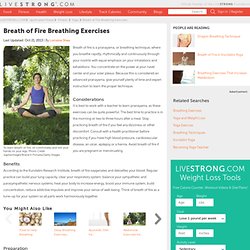
Raising Your Vibrational Frequency ~ Breathing Technique. There are probably many ways to raise your vibrational frequency but the breathing technique that I used to save my life had the benefit to me of raising my vibrational frequency, opening me up to the other side and helping to bring out the joy that lives inside each of us.
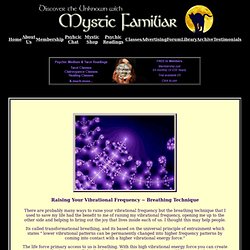
I thought this may help people. Its called transformational breathing, and its based on the universal principle of entrainment which states " lower vibrational patterns can be permanently changed into higher frequency patterns by coming into contact with a higher vibrational energy force. " How To Practice Transformational Breathing Step-by-Step. Throwing away the comfort blanket with Transformational Breathing. I am lying down on a comfy couch in a private treatment room in West London's Special Yoga Centre.
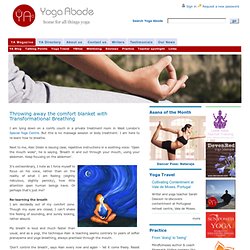
But this is no massage session or body treatment: I am here to re-learn how to breathe. Next to me, Alan Dolan is issuing clear, repetitive instructions in a soothing voice: 'Open the mouth wider', he is saying. 'Breath in and out through your mouth, using your abdomen. Keep focusing on the abdomen'. It's extraordinary, I note as I force myself to focus on his voice, rather than on the reality of what I am feeling (slightly ridiculous, slightly panicky), how little attention span human beings have. Breath Wave and the Speedbump of Life. To begin to unravel the mysteries and power of the breathing improvement we need to combine the approaches of science, psychological exploration and spiritual practice.

My intention is to awaken you to the awesome power of breathing and to guide you toward an ability to harness some of its power. Heightened breathing experiences result in heightened quality of life. Didgeridoo healing breath. The breath "Breathing may be considered the most important of all the functions of the body, for, indeed, all the other functions depend upon it.

" - Ramacharaka: Hindu-Yogi Science of Breath. Oxygen is fuel for our body as much as food is. The body is designed to take 75% of its energy through breathing in while we eliminate 70% of our toxins when breath out. Oxygen also cleanses the cells by oxidation and enables waste products to be carried back to the lungs via the bloodstream. 11 Fascinating Facts About Breathing. Throughout our yoga, meditation, and pranayama practices, there is a huge emphasis on the breath.
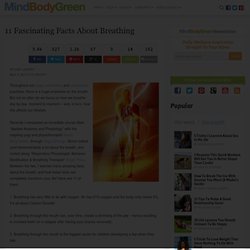
But not so often do we focus on how we breathe day by day, moment to moment – and, in turn, how this affects our lifestyle. Recently I completed an incredible course titled “Applied Anatomy and Physiology” with the inspiring yogi and physiotherapist Simon Borg-Olivier, through Yoga Synergy. Simon talked (and demonstrated) a lot about the breath, and invited along “Respiratory Physiologist, Behavior Modification & Breathing Therapist” Roger Price. Between the two, I learned many amazing facts about the breath, and how these facts can completely transform your life! Here are 11 of them: 1. 2. 3. 4. 5. 6. 7. 8. Nose Breathing And Yoga. Alternate nostril breathing is also called "anuloma viloma" or "nadi shodhana" (in Sanskrit, the ancient language of yoga).

As the name suggests, this breathing exercise involves alternating which nostril you breathe out of by blocking the opposite nostril. Alternate nostril breathing is fairly easy to learn and has many health benefits. It is often practiced at the beginning or end of a yoga session. One benefit of alternate nostril breathing is the revitalization it provides you when you feel tired or even stressed out. The exercise gives your body a boost of energy. Humming Bee Breath. Wednesday 16 April, 2014.
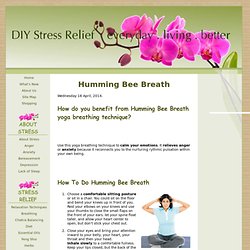
How do you benefit from Humming Bee Breath yoga breathing technique? Use this yoga breathing technique to calm your emotions. It relieves anger or anxiety because it reconnects you to the nurturing rythmic pulsation within your own being. Qi Gong Breathing Technique. Chi, also spelled qi or ki, is our life-giving energy.

Martial arts, traditional Chinese medicine and acupuncture are all based on focusing, balancing or aligning chi. In particular, the practices of qigong, also called chi kung, and tai chi teach students to focus on and tap into chi. Students of martial arts like karate and aikido use chi force to chop through boards or deflect an attack. To be more effective with martial arts punches and strikes, it helps to learn how to focus chi into your fist. Stand in a neutral, comfortable stance and rub your hands together briskly, as if trying to warm them up. Place your hands just below your belly button and take a deep breath. Raise your hands as if holding a small basketball, and imagine the ball of light from your belly now being in your hands.
Bring your hands closer together again when you feel the connection weaken, but don’t let them touch. Take a deep breath when you finish. Play with the size and shape. Excellent Pranayama Explanation from Himalayan Yoga Swami. Yoga Breathing (Pranayama) - Safety of Breathing Exercises. Written by: ljpasion Practicing breathing exercise or Pranayama should be safe if you are supervised by an instructor.
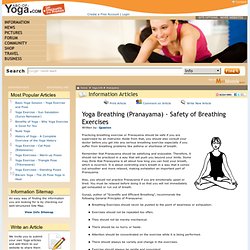
Aside from that, you should also consult your doctor before you get into any serious breathing exercise especially if you suffer from breathing problems like asthma or shortness of breath. Remember that Pranayama should be satisfying and enjoyable. Therefore, it should not be practiced in a way that will push you beyond your limits. Some may think that Pranayama is all about how long you can hold your breath, which is incorrect. Yoga Breathing - Breath Control (Pranayama) The Power of Effective Breathing Pranayama forms a vital step in the path to ascendancy through Yoga. Pranayama is derived from 2 Sanskrit words - Prana (life force) and Ayama (control). Therefore, in its broadest description, Prananyama would mean the control of the flow of life force. Pranayama - The Art of Yoga Breathing. When the Breath wanders, the mind is unsteady, but when the Breath is still, so is the mind still.
" - Hatha Yoga Pradipika. Kundalini Yoga - Pranayama - Breathing Techniques. Long Deep Breathing and Breath of Fire Pieter Schoonheim Samara For those that have been doing Long Deep Breathing and Breath of Fire for many years, the breath is so natural and easy that unless one is also teaching one might not easily focus on what the difficulty could possibly be. Pranayama, Yoga Breathing, Pranayama types. "Pranayama is control of Breath". "Prana" is Breath or vital energy in the body. On subtle levels prana represents the pranic energy responsible for life or life force, and "ayama" means control. So Pranayama is "Control of Breath". One can control the rhythms of pranic energy with pranayama and achieve healthy body and mind. Patanjali in his text of Yoga Sutras mentioned pranayama as means of attaining higher states of awareness, he mentions the holding of breath as important practice of reaching Samadhi.
Five types of prana are responsible for various pranic activities in the body, they are Prana, Apana, Vyan, Udana & Samana. How I Learned To Fall Asleep In Under 1 Minute. I couldn’t wait to put the trick to the test, and to my complete disbelief, I woke up the next morning unable to even remember getting to the eighth second of the exhale because it knocked me out that fast. For the next four nights leading up to the big day, even as my stress increased, I was able to fall asleep the minute I tried the 4-7-8 trick. I also used it to relax in the moments leading up to the speech.